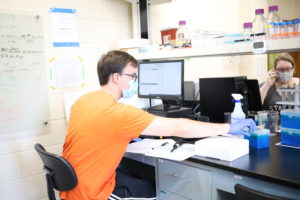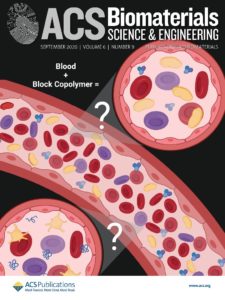Article written by Paul Alongi.
Rachel Getman became the first woman to receive tenure in Clemson University’s Department of Chemical and Biomolecular Engineering in the same year the department celebrated a century of granting degrees.
That was three years ago. Now Getman is first through the door for another honor, one that reflects her national prominence in research, scholarship and teaching.
Getman is the first recipient of the Murdoch Family Endowed Professorship in Chemical and Biomolecular Engineering.
The professorship comes with funding that Getman said she expects to put into hiring a graduate student to help further her lab’s research.
“Every person that you have doing research is an opportunity to work on and explore another problem,” Getman said. “It’s very helpful. I thank all those who have mentored and supported me, those who nominated me for the professorship, and the Murdoch family for their support of Clemson University faculty.”
Larry Murdoch provided the endowment that made the professorship possible. Murdoch received his Bachelor of Science in chemical engineering from Clemson in 1963 before going on to graduate school at Iowa State University and a successful career, first in chemical plant operations and then the engineering and construction industry.
He has traveled the world and once lived in Europe for five years, but he hasn’t forgotten what Clemson has meant to him. Murdoch said the quality and dedication of the faculty, led by then-Department Chair Charles Edward Littlejohn, Jr., inspired him and helped lead him to success.
“That’s why I wanted to dedicate the endowment to recognize faculty,” he said. “The quality of an educational institution really boils down to the quality of the faculty, and I know it’s difficult to attract and retain good faculty. There is a lot of competition, and I just want to do a small part to help in that area.”
Murdoch also said that since he began supporting the department in 2011, he has been impressed and inspired by the commitment and improvements implemented by former Department Chair Douglas E. Hirt and the current department chair, David A. Bruce.
Getman’s research is helping lay the groundwork to create more efficient, more effective and less expensive catalysts. Catalysts accelerate the rate of chemical reactions and are crucial to mass-producing a vast range of products from gasoline and diesel fuel to fertilizer and plastic.
“Everything that you’re touching right now has probably seen a catalyst,” Getman said.
Getman’s main contribution has been to develop a multiscale modeling method for quantifying thermodynamics and kinetics of aqueous phase reactions at solid interfaces.
“It’s something that isn’t well established in my field but needs to be to understand a large class of catalytic chemistry,” she said. “To perform simulations at the molecular level is pretty challenging. You have to predict ahead of time all of the correct features that you would want to incorporate into your model. Because no one has a microscope that can look at that level and tell you what’s going on, you have to use your own intuition. Usually, you’re learning as you’re going.”
Getman’s lab includes two post-doctoral researchers, five Ph.D. scholars, one master’s student and one honors undergraduate. Her lab took in 11 interns over the summer when other research opportunities were cancelled because of COVID-19.
Much of her lab’s work involves creating models of chemical reactions on computers and can be done virtually.
“We offered a lot of positions to give people experience doing research they wouldn’t have had otherwise because of the pandemic,” Getman said.
Bruce said Getman is well deserving of the professorship.
“Dr. Getman receives funding from multiple agencies, publishes research in high-quality journals and has an excellent record of mentoring undergraduates,” he said. “Clemson is better off for having her here, and I offer her my deepest congratulations for this professorship.”
Getman’s lab is also collaborating with O. Thompson Mefford, an associate professor of materials science and engineering at Clemson. Their work to design magnetic materials could have applications in biomedicine and electronic devices, Getman said.
“We use our methods (created in the Getman lab) to calculate magnetic properties at the molecular level and learn how we can tune those properties to optimize the material for a particular function,” she said.
Getman said what she likes best about her work is helping people reach their potential and achieve their career and personal goals, a value that she sees reflected in her colleagues at Clemson.
All of the students and post-doctoral researchers who have worked in Getman’s lab have been placed in positions that have closely aligned with their goals, she said.
“One of my best accomplishments is that the people who come through my group create a career goal and then they achieve it– and I can’t see how there can be anything better than that as a professor,” she said.
About the Murdoch Family:
Three consecutive generations of Murdochs have graduated from Clemson University. Larry Murdoch, whose donation funded the Murdoch Family Endowed Professorship, was the second generation. He arrived at Clemson after growing up in Abbeville County and received a Bachelor of Science in chemical engineering in 1963, a degree that he credits with preparing him for graduate school and a successful career. His father, Earle Murdoch, was the first in the family to graduate from Clemson, receiving an agronomy degree in 1929. Three of Larry Murdoch’s children also went to Clemson. Jeffrey Murdoch received a Bachelor of Science in chemical engineering in 1994 and then a Master of Science in computer science in 2000. Brian Murdoch received a Bachelor of Science in biochemistry in 1997. Lindsay Murdoch White received a Bachelor of Science in health science in 2000. A fourth generation is represented by a grandson who is a freshman starting this year. Larry Murdoch retired from full-time work in 2014 but at 79 years old continues to work as a consultant. He and his wife, Pat, live on Greenville’s Eastside.







